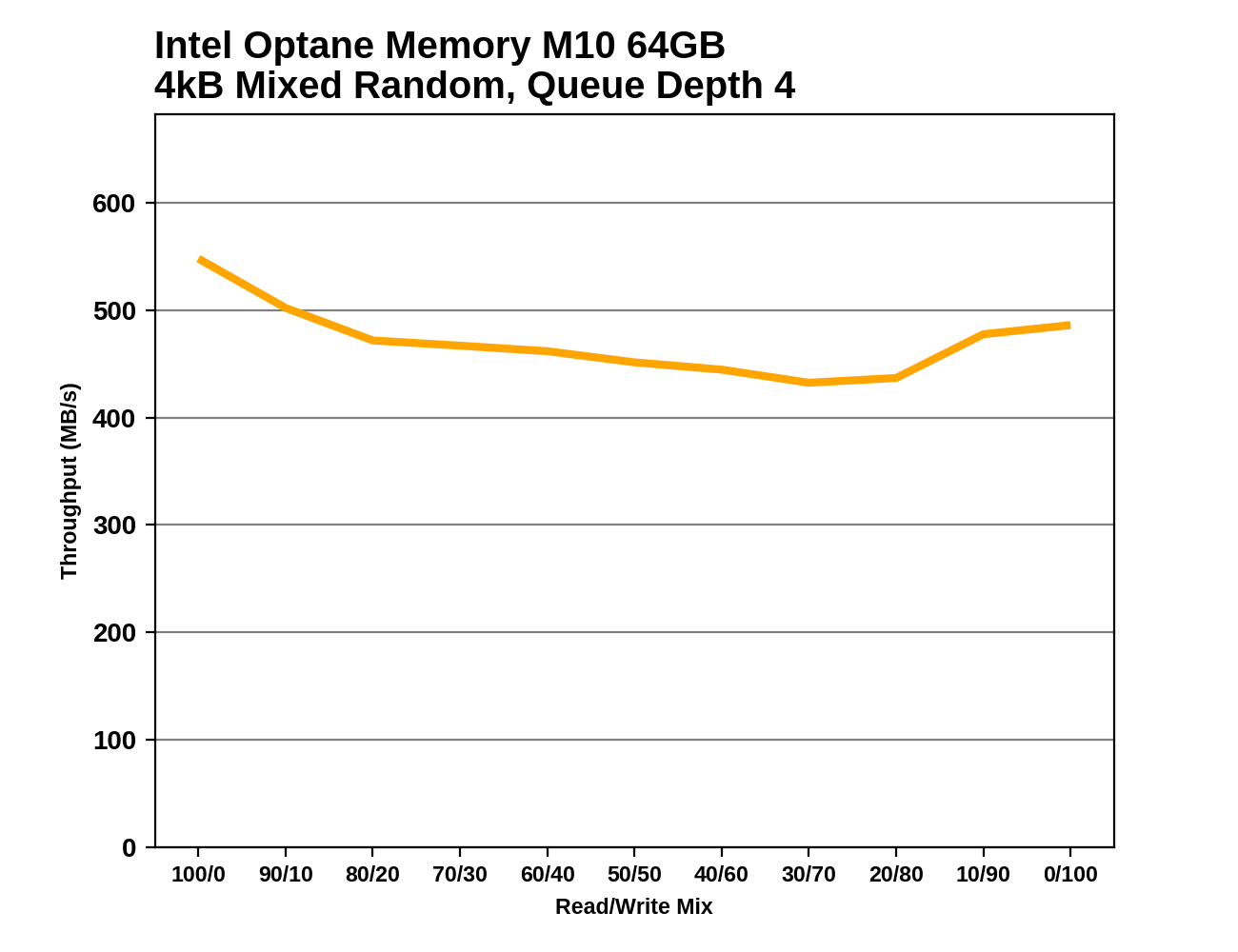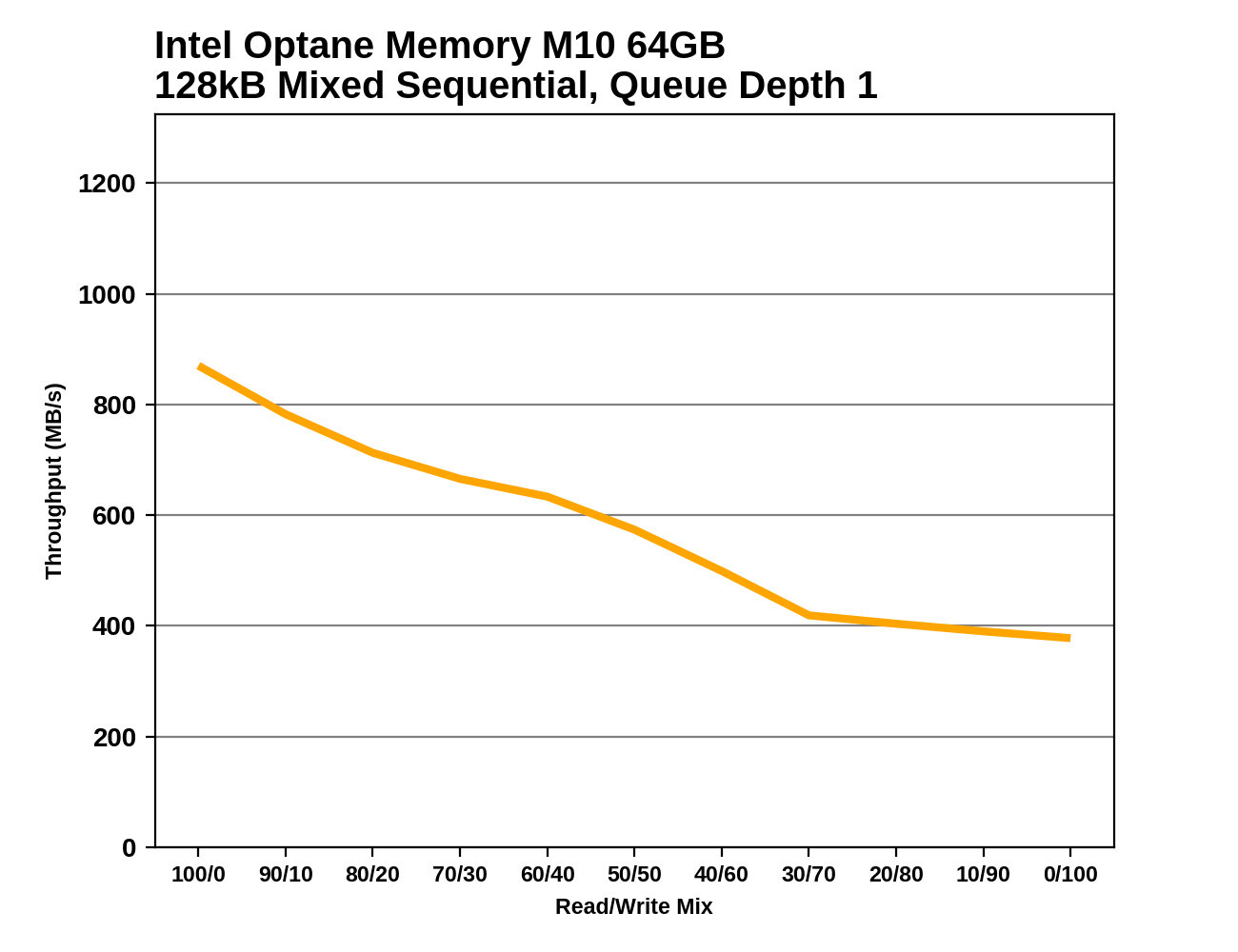The Intel Optane Memory M10 (64GB) Review: Optane Caching Refreshed
by Billy Tallis on May 15, 2018 10:45 AM EST- Posted in
- SSDs
- Storage
- Intel
- PCIe SSD
- SSD Caching
- M.2
- NVMe
- Optane
- Optane Memory
Mixed Random Performance
Our test of mixed random reads and writes covers mixes varying from pure reads to pure writes at 10% increments. Each mix is tested for up to 1 minute or 32GB of data transferred. The test is conducted with a queue depth of 4, and is limited to a 64GB span of the drive. In between each mix, the drive is given idle time of up to one minute so that the overall duty cycle is 50%.

Unsurprisingly, the mixed random I/O test produces crap performance from the hard drive and the two cache configurations where the cache is too small for this test. The 118GB Optane SSD 800P is more cache than this test needs, and it performs almost as well as the Optane SSD 900P.
 |
|||||||||
When used as a cache for this test, the largest Optane SSD 800P shows slightly different performance characteristics than when it is treated as a standalone drive, but in either case it is a strong performer across the board. The smaller Optane drives aren't large enough to cache the entire working set of this test and can't do much to improve performance over the hard drive.
Mixed Sequential Performance
Our test of mixed sequential reads and writes differs from the mixed random I/O test by performing 128kB sequential accesses rather than 4kB accesses at random locations, and the sequential test is conducted at queue depth 1. The range of mixes tested is the same, and the timing and limits on data transfers are also the same as above.

All of the Optane configurations easily outperform the SATA drives on the mixed sequential I/O test. The 64GB and 118GB modules are tied when tested as standalone drives and close when tested as cache devices, and the cache performance is 30-40% faster than the standalone SSD performance. The 32GB module is substantially slower and performance is much closer between caching and standalone SSD use.
 |
|||||||||
The performance improvements in the caching configurations over the standalone drive configurations generally apply throughout the mixed sequential test. The main exception is in the early phases of the test with the 32GB cache, where cache performance falls far short of the standalone drive performance. Once the proportion of reads has dropped to 70%, the cache configuration comes out ahead.










96 Comments
View All Comments
TrackSmart - Tuesday, May 15, 2018 - link
People seem to be talking around each other in these threads, without actually reading the substance of each person's reply.Dr. Swag didn't mention ONLY using a 500GB SSD. Just the opposite. He/she was suggesting that you could use a 500GB SSD for both a boot drive AND a 64GB cache drive. So you end up with ~440GB of normal SSD space (enough for most programs) AND a ~60GB cache drive to speed up your HDD accesses. All for the same price as adding a 64GB optane drive.
Addressing Dr. Swag's actual comment: I partially agree. One downside to the arrangement you suggested is that most affordable SSDs have lower write endurance than cache drives. They are also likely to be slower than an optane drive (but still fast compared to HDDs). And if your SSD boot/cache all-in-one drive dies, you might lose data on both the SSD and the HDD.
Regarding WithoutWeakness: Your comment makes sense if you are accessing the same subset of data over-and-over again. But if you are accessing a block of data ONCE to run an analysis and then moving onto a new block of data, then you will experience HDD speeds. Same goes for the first access to the data in cases where you will be using it multiple times. Slow the first time, faster in future times. So the downsides of a small cache will remain in a number of scenarios.
I personally think that Intel missed the boat with Optane. These solutions would have been a lot more convincing when SSD storage was a lot more expensive (i.e. 5+ years ago) and before other caching options existed for making use of 'normal' SSDs.
ಬುಲ್ವಿಂಕಲ್ ಜೆ ಮೂಸ್ - Tuesday, May 15, 2018 - link
Power loss protection ?From what I know so far, the MX500 (500GB) cache contains unique data that has not yet been written to normal nand and Crucial does not recommend using an SLC cache unless you have battery backup protection
An Optane cache drive is a "copy" of data already on the hard drive (or SSD) and I don't see a problem with power loss resulting in data loss once you clear the cache
SkipPpe - Friday, May 18, 2018 - link
Something like an Intel 3510 would be a better drive to use for this.ಬುಲ್ವಿಂಕಲ್ ಜೆ ಮೂಸ್ - Tuesday, May 15, 2018 - link
DOH......Nevermind!
sharath.naik - Tuesday, May 15, 2018 - link
I was wondering if the lifespan of these are no better than SSD. wont this burn out much faster than the drives lifespan if used as a cache for it?MajGenRelativity - Tuesday, May 15, 2018 - link
Optane drives are more durable than the average SSDCheapSushi - Wednesday, May 16, 2018 - link
Even more so than MLC NAND, which seems to be getting harder and harder to find (aside from Samsung's PRO line).Drumsticks - Tuesday, May 15, 2018 - link
Is anybody else interested in the performance of the 800p as a cache drive? The difference between an Optane SSD 800p and a 1TB HDD versus a 1TB SATA drive nowadays is less than $15, so it's pretty comparable for effectively the same capacity of storage. On the other hand, in the 25 or so graphs presented in this review, the 118GB caching solution outperforms a SATA drive, sometimes handily, in 24 of them. The 25th is power consumption, and one of them has a single loss in run 1 of the latency measurement for the heavy test.Hell, sometimes that solution outperforms the 900p. Why would you pick a comparably priced 1TB SATA SSD over something like that? If you need less storage, a 500GB will perform even worse than a 1TB, and a 250GB would be even worse still. Going down in capacity on the Optane drive would still probably keep you in the range of the SATA drive, while leaving you with double or quadruple the capacity.
Giroro - Tuesday, May 15, 2018 - link
"58GB 800P is functionally identical to the 64GB M10 and both have the exact same usable capacity of 58,977,157,120 bytes."Hold on, either something is wrong or that is straight-up false advertisement, a new low that is far beyond how storage manufacturers usually inflate their capacity specs. Don't just breeze past the part where Intel may be illegally marketing this thing. As far as I know Optane doesn't use over-provisioning, and it definitely isn't the normal GiB/GB conversion issue or the typical "formatting" excuse that doesn't actually apply to solid state media, so what gives?
It has to be a mistake, right?
The_Assimilator - Wednesday, May 16, 2018 - link
> it definitely isn't the normal GiB/GB conversion issueActually, it is.